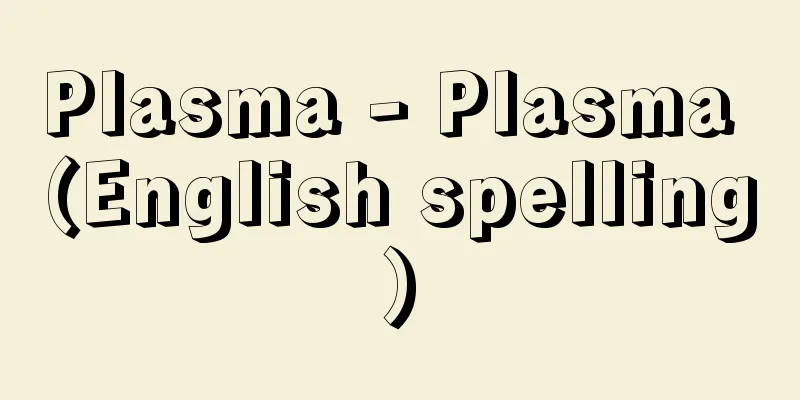Plasma - Plasma (English spelling)

|
The word plasma is a Greek word meaning "a state created by pouring into a mold", and in physiology it means "blood plasma" and in cytology it means "protoplasm", but in physics it is understood as "a group of interacting charged particles". The concept of plasma in physics began in 1929 when American Langmuir used this word to describe the state of a positive column that occurs in a discharge tube. Today, it is often used to describe the state of an ionized gas at ultra-high temperature, but this corresponds to the fact that matter changes state from solid to liquid to gas as the temperature is increased, and that at ultra-high temperatures it exhibits even more characteristic properties. In this sense, it is understood as the "fourth state of matter". [Akira Miyahara] Definition of Plasma Microscopically, plasma is a mixture of positively and negatively charged particles and neutral particles, and while it is necessary for it to be nearly neutral overall, this alone is not enough. The system under consideration must exhibit collective action as an aggregate, otherwise there is no need to take up the concept of plasma. For collective action to appear, the dimensions of the plasma must be sufficiently large compared to the Debye length, which is comparable to the average distance between charged particles. The Debye length λ D is Currently, when we talk about plasma, we often think of ionized gas, so we expect that both positive and negative charged particles can move, but according to the original definition, the system of lattice ions and electrons in a metal and the existence of positive and negative ions in an electrolyte solution can also be considered plasma. In fact, the concept of the Debye length necessary for the definition of plasma is derived from the theory of strong electrolytes. However, since the majority of applications of plasma are nuclear fusion and plasma processes, we will mainly deal with gas plasma as plasma here. In this case, the quantities required to consider a plasma system are the density of the ion species, electrons, and neutral particles that form the system, as well as the temperature of each particle, as well as the volume of the system as a whole, and the time constant of the diffusion of particles and energy. Density is expressed as the number of particles per unit volume, but temperature is often expressed in electron volts (eV), a unit of energy, rather than absolute temperature. This is because when expressing the relationships between plasma quantities, it is often expressed in the form of k B T multiplied by the Boltzmann constant k B = 1.38×10 -23 J/K rather than temperature itself, so it is convenient to regard the quantity k B T , which has the dimension of energy, as temperature and to refer to unit energy in terms of energy units. 1 eV is 1.602×10 -19 J, so 1 eV = k B T , and therefore the absolute temperature T equivalent to 1 eV is 1.16×10 4 K. As a rough guide, 1 eV can be considered to be approximately 10,000 degrees Celsius. [Akira Miyahara] History of Plasma ResearchResearch on plasma began with Langmuir's study of positive columns in discharge tubes, but subsequent research has estimated that the existence of matter to which this concept can be applied is more than 99.9% of the universe. The Debye length, a quantity that characterizes plasma, is 10 micrometers in discharge tubes and about 10 meters in planetary space, which is sufficiently short compared to the dimensions of the systems being considered. Sweden's Alfven was awarded the Nobel Prize in Physics in 1970 for his achievements in plasma physics research in outer space. Plasma research on earth has been extensively carried out in relation to discharge phenomena and their applications that have accompanied the development of electrical engineering. However, it was in connection with nuclear fusion research that plasma research has been epoch-making. Nuclear fusion research was started with the aim of utilizing the nuclear fusion reaction energy in a controlled manner, which had unfortunately been put to practical use by hydrogen bombs. This research has been openly conducted under international collaboration since the 1st International Conference on Peaceful Uses of Atomic Energy in 1955. The immediate goal was to realize a super-high temperature plasma of over 100 million degrees Celsius using a mixture of deuterium and tritium, satisfying the so-called Lawson condition that the product of density and confinement time is 10 20 sec/m 3 , and this goal was achieved by JET (Joint European Torus). The next step is the launch of the International Thermonuclear Experimental Reactor (ITER) project, which aims to conduct research into burning plasma and demonstrate the key technologies for sustaining 500 megawatts of fusion power for a long period of time. The results of the Engineering Design Activity (EDA) completed in 2001 are being developed further, and technical preparations for the start of construction of the ITER experimental reactor are steadily progressing. In parallel with this, official consultations have been held among government representatives of the EU (European Union), Japan, Russia, China, the United States, and South Korea. By the end of 2003, the draft agreement, the composition and operation of the ITER International Research Organization, procurement methods and allocation of responsibilities, risk management, and intellectual property rights were almost completed. Negotiations on the construction site and cost sharing by high-ranking government officials began in December 2003. Regarding the location of ITER, the EU strongly advocated Cadarache (in the south of France), while Japan advocated Rokkasho-mura (in Aomori Prefecture), and neither side would give in, resulting in a stalemate for some time. However, in June 2005, it was decided that the facility would be built in Cadarache. Another motivation for plasma research is its connection to the ionosphere and communications. The density of charged particles gradually increases above about 50 km above the ground, and the plasma state is reached at a maximum at about 350 km. Research into the reflection of short-wavelength radio waves there and the intermodulation effect (Luxembourg phenomenon) has been actively carried out with the development of wireless communication. Other research is being carried out into plasma propulsion in connection with understanding electromagnetic phenomena in space and with spacecraft. In contrast to nuclear fusion research, research into low-temperature plasmas became more active around 1980, in line with the demand for mass production of information devices. The field known today as plasma engineering encompasses a wide range of applications, from plasma processing for IC (integrated circuit) manufacturing, plasma coatings such as PVD (Physical Vapour Deposition) and CVD (Chemical Vapour Deposition), optical technology using plasma, plasma displays for TVs, and even artificial diamond production and environmental purification. [Akira Miyahara] Plasma PhysicsPlasma exhibits unique properties not seen in ordinary gases due to the Coulomb interactions between charged particles, and the field of physics that studies these properties is called plasma physics. [Akira Miyahara] Plasma generation, confinement, and heatingTo generate plasma, gas must be ionized, so energy equal to or greater than the ionization energy is applied to the orbital electrons of the gas molecules or atoms. In the case of hydrogen plasma, the ionization energy of hydrogen atoms is 13.6 eV, so more energy must be applied. When heating the gas to a high temperature, the particles follow a Boltzmann distribution and include high-energy particles, so ionization is possible without reaching a temperature of 150,000°C, which corresponds to 13.6 eV. Normally, to generate plasma, a current is passed through a gas that has been weakly ionized in advance by ultraviolet irradiation, etc., and the gas is heated by Joule heat (Ohmic heating). When a magnetic field is applied to the plasma, the plasma particles, which are charged particles, orbit around the magnetic field lines like a cyclotron. A method of heating the gas by applying a high-frequency wave that resonates with the frequency (called the gyro frequency or cyclotron frequency) from the outside (cyclotron resonance heating) is an efficient heating method. Neon tubes and fluorescent lamps, which are applications of plasma generated from gas sealed in a glass container, contain many neutral particles, and if the plasma is left alone it will lose energy through thermal conduction and recombination and become an ordinary gas, so power is constantly supplied from the outside to maintain the plasma state. Fusion core plasma requires the generation of deuterium and tritium plasma at ultra-high temperatures of over 100 million degrees Celsius. To heat to such high temperatures, the time constant for the escape of energy and particles must be made long enough to allow for effective heating. One of the important issues in nuclear fusion research is the confinement of high-temperature plasma. When plasma comes into contact with a container, its surface evaporates and the plasma cools due to radiation loss, so confinement in a normal container is impossible. There are two methods for confining high-temperature plasma: magnetic confinement, which takes advantage of the fact that plasma is a collection of charged particles, and inertial confinement, which takes advantage of the fact that particles have mass. The former method can achieve a confinement time of several seconds even with plasma at 100 million degrees Celsius by increasing the size of the plasma, but the latter method is usually less than nanoseconds (10 -9 seconds), which is closely related to the speed of the particles. There are two types of nuclear fusion reactors: magnetic confinement, which considers a density of 10 20 /m 3 and a confinement time of several seconds, and inertial confinement, which considers a density of 10 29 to 10 30 /m 3 and a confinement time of less than nanoseconds, which correspond to the methods of confining high-temperature plasma. When attempting to heat plasma to above 100 million degrees Celsius, the electrical resistance of the plasma becomes smaller at high temperatures, making ohmic heating ineffective. In this case, other effective methods include injecting high-energy neutral particles and heating through energy relaxation with the plasma particles (neutral particle injection heating), or applying high-frequency waves that resonate with the ion cyclotron frequency (ion cyclotron resonance heating). Loss mechanisms in high-temperature plasma include particle loss due to incomplete confinement, thermal conduction loss, as well as radiation loss and charge exchange loss, and the overall balance of energy and particles is a challenge in nuclear fusion research. [Akira Miyahara] Plasma ModelIn order to understand and describe the properties and behavior of plasma, it is necessary to look at it from various aspects. This model can be broadly divided into two: (1) the view that it is a continuous medium that forms a space that transmits waves, and (2) the view that it is a collection of charged particles. These two views are complementary, and it can be said that plasma can only be truly understood by looking at it from both sides. [Akira Miyahara] Single particle modelWhen the external magnetic field is uniform and steady and the only external force is the Lorentz force, the center of rotation of the charged particle moves along a single magnetic field line, but when the magnetic field is non-uniform or an external force is applied, the center of rotation also starts to move in a direction perpendicular to the magnetic field lines. The movement perpendicular to the magnetic field is called drift motion. This concept can be used to describe the first stage of the drift motion of plasma particles in a simple torus magnetic field, such as when confined by a so-called mirror magnetic field with strong linear fields at both ends, or when the cut surfaces of a doughnut are all solenoid coils (coils made of a conducting wire wound many times in a cylindrical shape). This type of plasma model is called the single particle model. [Akira Miyahara] MHD ModelSince plasma is a collection of many charged particles, it can be described by the Boltzmann equation. Furthermore, in high-temperature plasma, as a first approximation, the collisions between particles on the right-hand side of the Boltzmann equation can be ignored, so it can be described by an equation (called the Vlasov equation) that only takes into account the electromagnetic field caused by collective motion as the interaction between particles. Plasma can be considered as a mixture of ions and electrons, but since the masses of ions and electrons differ by more than three orders of magnitude, the contribution of mass, i.e., the motion of plasma, is generally the motion of ions, and since electrons are very mobile and their average speed is much greater than that of ions, the current is mostly due to the contribution of electrons. A system that considers the motion of plasma as a whole and the two equations that govern the behavior of the current independently is called the MHD model, and is suitable for discussing the macroscopic motion of plasma (MHD is an abbreviation for magnetohydrodynamics). [Akira Miyahara] Plasma Oscillations The most characteristic wave motion in plasma is plasma oscillation, which occurs when a macroscopically electrically neutral plasma is slightly displaced from its equilibrium position and a force acts to restore the displacement. The frequency of the oscillation depends on the plasma density, but since it is usually considered that electrons are mainly moving and ions are stationary, the plasma frequency ω pe is: The plasma oscillations, which are based on charged particles, characterize the plasma and are essentially different from the longitudinal waves that appear in plasmas and ordinary materials, such as sound waves. The damping mechanism of these waves is the famous Landau damping, which can be explained by the exchange of energy with the motion of electrons whose phase velocity is close to that of the waves. Plasma oscillations are a typical type of oscillation excited in plasma, but there are many other types of oscillations excited in plasma (as a medium). In this case, in a uniform, stationary plasma, the medium is characterized by the dielectric constant, a tensor quantity. By analyzing the inherent oscillations by setting this quantity to zero in Maxwell's equations for external charge and current, it is possible to obtain the waves excited in the plasma. Typical examples include longitudinal waves such as ion acoustic waves, and transverse waves such as electromagnetic waves, ion cyclotron waves, Alfven waves, and Whistler waves. Whistler waves are famous for being the waves that carry the signals of lightning generated in the southern hemisphere to the northern hemisphere along the magnetic field lines of the Earth's magnetic field. [Akira Miyahara] Drift WavesWhen the plasma has a spatially non-uniform density, waves in the plasma are affected in various ways. The most notable is the appearance of a type of wave that does not exist in a uniform plasma. This type of wave is called a drift wave, because its generation mechanism is closely linked to the drift of charged particles in a magnetic field. Plasma is considered to be a collection of charged particles, and the effect of direct collisions between particles on the movement of charged particles in plasma is relatively small. In the first approximation, the charged particles move freely in an electromagnetic field applied from the outside world, and in the second approximation, they are affected by electromagnetic fields that arise due to the collective movement of other charged particles. It is at a more detailed stage of discussion that direct collisions with individual particles become an issue and statistical treatment is required. In fact, most of the plasma-like properties can be obtained in the first approximation. [Akira Miyahara] Plasma electrical conductivity and its temperature dependenceElectrons are the main players in transport phenomena such as electrical conduction and thermal conduction in plasma. For example, the temperature dependence of plasma's electrical conductivity is proportional to the 3/2 power of T , meaning that the higher the temperature, the smaller the resistance. The resistivity parallel to the magnetic field of magnetically confined plasma is about the same as that of stainless steel at 100 eV (about 1 million degrees Celsius), but at 1 kilo eV (about 10 million degrees Celsius) it is about the same as that of copper, and in the core plasma of a fusion reactor at 10 kilo eV (about 100 million degrees Celsius), it is one-thirtieth of that of copper. This is why ohmic heating is ineffective when heating plasma at temperatures above 10 million degrees Celsius, and high-frequency heating or neutral beam injection heating is required. [Akira Miyahara] Plasma and RadiationIn a plasma, electrons move violently around ions, and radiation is generated due to the acceleration of the electrons. This usually includes bremsstrahlung radiation, which has a peak wavelength in the soft X-ray region, which has a relatively long wavelength among X-rays, and synchrotron radiation, which is caused by the gyroscopic motion of electrons when a magnetic field is present. The extent to which this radiation generated inside the plasma is emitted outside the plasma is related to the equilibrium between the radiation and the plasma, and is usually expressed by the optical thickness. In laboratory and reactor plasmas, the plasma is transparent to bremsstrahlung radiation but opaque to synchrotron radiation, and is considered to be similar to blackbody radiation. In addition, line radiation caused by transitions between the electronic levels of multiply charged ions in the plasma is an important mechanism for the loss of internal energy in the plasma, especially in the generation of high-temperature plasmas, and depending on the wavelength range, these are absorbed by the plasma or escape to the outside world. By observing this line radiation, we can obtain a lot of information about plasma parameters. [Akira Miyahara] Plasma phenomena around the EarthThe Sun is also a plasma confined by gravity due to its own mass, but it is thought that plasma is also circulating throughout almost the entire solar system. In particular, around the Sun, plasma has a density n of 10 11 - 10 15 /m 3 and a plasma temperature T of about 100 eV, and is observed as the corona during a solar eclipse. Near the Earth, the magnetosphere is formed over a distance of about 10 times the radius of the Earth, so plasma is captured. The ionosphere, well known for radio wave propagation, extends from 70 to 500 kilometers above the ground. In the F-2 layer (height 200 to 500 kilometers), where the density is the highest, the plasma density and temperature are about 10 12 /m 3 and 0.1 eV, respectively, but it is known from rocket observations that this region also contains a large amount of neutral particles. The Van Allen belt is a plasma layer located about 12,000 kilometers above that, where high-speed ions and electrons captured by the Earth's magnetic field actively radiate. The aurora is also plasma, but it is a luminous phenomenon seen in the sky at altitudes of several hundred kilometers in high latitudes. It is caused by electrons with energies of about 10 kiloeV that penetrate into the ionosphere in the auroral zone along the magnetic field lines of the Earth's magnetic field, causing atoms and molecules in the atmosphere to glow. [Akira Miyahara] Plasma ApplicationsThe most important application of plasma is the fusion reactor plasma, which is discussed in detail in the "Nuclear Fusion" section. Neon signs are neon plasma with a plasma density of 5x1018 / m3 , electron temperature of 2.5eV, and ion temperature of 0.15eV. Fluorescent lights are made by sealing a small amount of mercury and 100 Pascal argon, xenon, krypton, etc. in a discharge, and the resulting 253.7 nanometer (nm) resonance line of mercury excites a fluorescent material coated on the tube wall, producing a near-white light emission; more than 20% of the total input is emitted as light, so they are widely used. Plasma displays have made rapid progress since the 1990s and have been put to practical use. They are characterized by being thin, lightweight, completely flat, and have large screens, and are replacing cathode ray tube displays along with liquid crystal displays. In principle, a pulse voltage is applied between electrodes through a discharge stabilizing resistor to cause a discharge. Information is displayed using the light generated by the discharge, and the color of the display uses neon's 585.6 nanometers for red, but for color displays, ultraviolet rays from xenon discharge are used to excite vacuum ultraviolet phosphors to emit light. The use of plasma as a heat source for welding and cutting metals began with arc welding, but in recent years plasma jets, which utilize even higher temperature plasma, have been devised and are now used for high-speed, precise cutting of materials. Plasma processing, which applies the plasma excitation reactions of active chemical species in plasma, is at the cutting edge of a wide range of material processing technologies, including plasma CVD, plasma etching, reactive ion etching, plasma polymerization, plasma oxidation/nitridation, and carbon film generation, and is expected to continue to develop in the future, including IC processing. Since 2000, plasma has also begun to be used to solve environmental problems, such as the generation of negative ions and high-temperature waste treatment. [Akira Miyahara] "Physics of Plasma" by Ichimaru Setsuo, edited by Nishijima Kazuhiko (1981, Sangyo Tosho)" ▽ "Kyoritsu Physics Lecture Series 23: Plasma Physics" by Mizuno Yukio (1984, Kyoritsu Shuppan)" ▽ "Introduction to Plasma Physics" by Miyamoto Takeo (1991, Iwanami Shoten)" ▽ "Introduction to Plasma" by Kawada Shigeo (1991, Kindaikagakusha)" ▽ " Introduction to Plasma Physics" by Francis F. Chen, translated by Uchida Daijiro (1996, Maruzen)" ▽ "Microwave Plasma Technology" edited by the Microwave Plasma Investigation Committee of the Institute of Electrical Engineers (2003, Ohmsha)" ▽ "Plasma Generation and Diagnostics - The Path to Applications" edited by the Japan Society of Plasma and Nuclear Fusion Research (2004, Coronasha)" ▽ "Iwanami Lecture Series: The World of Physics: Various Material Systems 4: Various Plasmas" by Takabe Hideaki (2004, Iwanami Shoten) "Plasma Physics and Nuclear Fusion" by Miyamoto Takeo (2004, University of Tokyo Press)" ▽ "Plasma Ion Processes and Their Applications" edited by the Institute of Electrical Engineers, Committee for the Investigation of Advanced Plasma Ion Processes (2005, Ohmsha)" ▽ "All About Plasma Energy -- Color Illustrations" edited by the Society of Plasma and Nuclear Fusion Research (2007, Nihon Jitsugyo Publishing)" ▽ "Discharge Plasma Engineering" by Yasaka Yasuyoshi (2007, Morikita Publishing)" ▽ "The Cutting Edge of Plasma Display Materials Technology" edited by Shinoda Den (2007, CMC Publishing)" ▽ "The World of Plasma" by Goto Kenichi (Kodansha, Bluebacks) [References] | | | | | | | | | | | | | |The figure shows the drift motion of electrons and ions in a magnetic field (vertical to the front of the page) and an electric field (direction of the arrow on the page) when there is an electrostatic field perpendicular to the static magnetic field. When accelerated, the radius becomes larger, and when decelerated, it becomes smaller, and drifts as shown in the figure . Examples of drift motion The figure shows the case where varies periodically with respect to . The density of electrons is represented by the shade of the blue line, and an electric field is generated in the direction shown in the figure, accelerating the electrons. Because the electrons have inertia, the phase becomes exactly the opposite after π/ω. Note: From "Plasma Physics" by Yukio Mizuno ©Shogakukan Generation of plasma oscillations Landau damping: Charged particles are accelerated with a phase and decelerated with a phase. Particles moving at a speed similar to the phase velocity of the wave will remain in phase or for a long time, and will continue to be subjected to only one of the forces of acceleration or deceleration. Particles faster than the phase velocity will decelerate, and particles slower than the phase velocity will accelerate, but in the case of a thermal equilibrium distribution, there are more slow particles, so the energy of the particles as a whole will increase. Considering that energy is constant overall, this means that the energy of the wave will decay by that amount. This is called Landau damping . Damping mechanism of plasma oscillations Source: Shogakukan Encyclopedia Nipponica About Encyclopedia Nipponica Information | Legend |
|
プラズマということばはギリシア語で「型に流し込んでつくられる状態」の意味で、生理学では「血漿(けっしょう)」、細胞学では「原形質」を意味するが、物理学においては「相互作用をする荷電粒子の集団」と理解される。1929年にアメリカのラングミュアが、放電管内に生ずる陽光柱の状態を表すのにこのことばを用いたのが、物理学におけるプラズマの概念の始まりである。現在では、超高温の電離気体ionized gasの状態を表すのに用いられることが多いが、これは、物質が固体、液体、気体と、温度を高くするにしたがって状態を変え、超高温の状態ではさらに特徴的な性質を示すことに対応している。この意味で「物質の第四の状態」と把握されている。 [宮原 昭] プラズマの定義プラズマは微視的にみると、正負の電荷をもつ粒子と中性粒子との混合物であり、全体的にはほぼ中性であることが必要であるが、それだけでは十分でない。考えている系が、集合体としての集団作用を示すことが必要で、そうでなければわざわざプラズマの概念を取り上げる必要はない。集団作用が現れるためには、荷電粒子間の平均距離にも比すべき「デバイの長さ」Debye lengthという量に比べて、プラズマの寸法が十分大きければよい。デバイの長さλDは 現在、プラズマとよぶときは、電離気体を考えることが多いので、正負の荷電粒子が両方とも動きうることを予想しているが、元来の定義によれば、金属中の格子イオンと電子の系や電解質溶液中の正負イオンの存在もプラズマと考えられる。実際、プラズマの定義に必要なデバイの長さの概念は、強電解質の理論から派生してきた。しかしプラズマの応用の大部分が核融合とプラズマプロセスであるため、ここではプラズマとして、気体プラズマをおもに取り扱う。この場合プラズマの系を考えるときに必要な量は、系を形成するイオン種、電子、中性粒子の密度および各粒子の温度であり、さらに系全体としての体積、粒子やエネルギーの拡散の時定数などである。 密度は単位体積当りの粒子の個数で表すが、温度は絶対温度で表すよりも、エネルギー単位である電子ボルトeVを用いることが多い。これは、プラズマ諸量の関係を表すときに、温度そのものよりもボルツマン定数kB=1.38×10-23J/Kを乗じたkBTの形で表すことが多いので、エネルギーの次元のもつ量kBTをそのまま温度とみなして、単位エネルギーもエネルギーの単位でよぶのが便利なためである。1eVは1.602×10-19Jであるから、1eV=kBTから、1eVに相当する絶対温度Tは1.16×104Kである。目安としては1eVは約1万℃と考えてよい。 [宮原 昭] プラズマの研究史プラズマの研究は、ラングミュアらの放電管内の陽光柱の研究に端を発しているが、その後の研究によって、この概念の適用できる物質の存在は、宇宙全体の規模で考えると99.9%以上であると見積もられている。プラズマを特徴づける量であるデバイの長さは、放電管では10マイクロメートル、惑星空間では10メートル程度と、考えられている系の寸法に比べて十分短い。スウェーデンのアルベーンの1970年ノーベル物理学賞受賞は、宇宙空間のプラズマ物理研究の功績による。 地上のプラズマの研究は、電気工学の発展に伴う放電現象やその応用に関連して広範囲に行われてきた。しかしなんといっても画期的にプラズマの研究を促進したのは、核融合研究との関連においてである。核融合研究は、不幸なことに水素爆弾によって実用化された核融合反応エネルギーの利用を、制御された形で行う目的で開始された。この研究が国際協力のもとに公開で行われたのは、1955年の第1回原子力平和利用国際会議以降のことである。当面の目標を、重水素・三重水素の混合プラズマで、1億℃以上の超高温プラズマを、密度と閉じ込め時間の積が1020sec/m3といういわゆるローソン条件を満たす形で実現することに置いたが、この目標はJET(Joint European Torus、欧州トーラス共同研究施設)によって達成された。次段階の目標として核融合実験炉ITER(イーター)(International Thermonuclear Experimental Reactor、国際熱核融合実験炉)計画が発足したが、この計画の目的は核燃焼プラズマの研究を行い、500メガワットの核融合出力を長時間持続し、発電炉の鍵(かぎ)となる技術を実証することである。2001年に完了した工学設計活動(EDA)の成果をさらに発展させ、核融合実験炉ITERの建設開始に向けた技術的な準備が着実に進められている。これと平行して、EU(ヨーロッパ連合)、日本、ロシア、中国、アメリカ、韓国の政府代表による公式協議が進められてきた。2003年末までに、協定書案、ITER国際研究機構の構成・運営・物品調達方式・分担、リスク管理、知的財産権などの検討はほぼ完了した。政府高官による建設地および費用分担の交渉が2003年12月より本格的に開始された。ITERの建設地に関しては、EUはカダラッシュ(フランス南部)、日本は六ヶ所村(青森県)への誘致を強く主張し、お互いに譲らず、膠着(こうちゃく)状況がしばらく続いていたが、2005年6月、カダラッシュに建設されることが決定した。 プラズマ研究のもう一つの動機として、電離層と通信との関係がある。地上約50キロメートルを超えるとだんだんと荷電粒子の密度が増してプラズマ状態となり、350キロメートルくらいで最大になる。そこでの短波長電波の反射や混変調効果(ルクセンブルク現象)の研究は、無線通信の発達とともに盛んに行われた。そのほかにも、宇宙電磁現象の理解や宇宙船との関連で行われているプラズマ推進の研究もある。 1980年ころから、核融合研究とは対照的に低温プラズマの研究が、情報機器の大量生産の要求と相まって盛んになった。現在プラズマ工学といわれている分野にはIC(集積回路)製造に関するプラズマ加工、PVD(Physical Vapour Deposition、物理蒸着法)、CVD(Chemical Vapour Deposition、化学蒸着法)などのプラズマコーティング、プラズマを用いる光技術、TVなどのプラズマディスプレー、人工ダイヤモンド生成から環境浄化まで広範囲な応用分野が展開されている。 [宮原 昭] プラズマ物理学プラズマは、荷電粒子間のクーロン相互作用のために通常の気体にはみられない特異な性質を現す。これらを研究する物理学の分野をプラズマ物理学という。 [宮原 昭] プラズマの生成・閉じ込め・加熱プラズマを生成するには、気体を電離させる必要があるので、気体分子や原子の軌道電子に電離エネルギー以上のエネルギーを与える。水素プラズマの場合、水素原子の電離エネルギーは13.6eVであるので、それ以上のエネルギーを与える必要がある。気体を高温にしていく場合には、粒子はボルツマン分布をしておりエネルギーの高い粒子も含まれるので、温度は13.6eVに相当する15万℃にしなくても電離することができる。通常、プラズマを生成するには、あらかじめ紫外線照射などによって弱く電離した気体に電流を流して、ジュール熱によって加熱したり(オーム加熱)、プラズマに磁場(磁界)が印加されている場合には、磁力線の周りを荷電粒子であるプラズマ粒子はサイクロトロンのように周回するが、その周波数(ジャイロ周波数、サイクロトロン周波数とよばれる)に共鳴する高周波を外部から加えて加熱する方法(サイクロトロン共鳴加熱)は効率のよい加熱法である。ガラス容器に封入されている気体から生成されるプラズマの応用であるネオン管や蛍光灯では、中性粒子が多く混在しているので、プラズマをそのまま放置しておくと、熱伝導や再結合によってエネルギーを失って通常の気体となってしまうので、外部から絶えず電力を供給してプラズマ状態を維持している。核融合炉心プラズマは、1億℃以上の超高温の重水素・三重水素プラズマの生成が必要となる。このような高温に加熱するためには、エネルギーや粒子の逸出の時定数を、十分長くして有効な加熱が行えるようにする必要がある。 核融合研究の重要な課題に高温プラズマの閉じ込めがある。プラズマが容器に触れるとその表面が蒸発し、放射損失によってプラズマが冷えてしまうので、普通の容器による閉じ込めは不可能である。高温プラズマの閉じ込めは、プラズマが荷電粒子の集合体であることを利用して磁場を用いる方法(磁場閉じ込め)と、粒子が質量をもっていることを利用する慣性閉じ込めの方法がある。前者はプラズマの寸法を大きくすることにより、1億℃のプラズマでも数秒程度の閉じ込め時間を得ることができるが、後者は粒子の速度に密接に関係して、通常はナノ秒(10-9秒)以下である。核融合炉の方式に、密度1020/m3、閉じ込め時間数秒を考える磁場閉じ込め方式と、密度1029~1030/m3、閉じ込め時間ナノ秒以下の慣性閉じ込め方式のものがあるのは、高温プラズマの閉じ込めの方法に対応している。 プラズマを1億℃以上まで加熱しようとすると、プラズマの電気抵抗は高温では小さくなるのでオーム加熱は有効でなくなる。この場合には、高エネルギー中性粒子を注入してプラズマ粒子とのエネルギー緩和によって加熱する方法(中性粒子入射加熱)や、イオンのサイクロトロン周波数に共鳴する高周波を印加して加熱する方法(イオンサイクロトロン共鳴加熱)が有効である。高温プラズマの損失機構としては、閉じ込めの不完全さによる粒子損失、熱伝導損失とともに、放射損失や荷電交換損失が問題となり、全体としてのエネルギーや粒子のバランスが核融合研究の課題である。 [宮原 昭] プラズマのモデルプラズマの性質やふるまいを理解し記述するためには、いろいろの側面からみる必要がある。このモデルには大きく分けて、(1)波動を伝える空間を形成する連続媒質とする見方と、(2)荷電粒子の集合体との見方、の二つがある。この二つの見方は相補的であって、この両面からみて初めてプラズマを本当に理解できるといえる。 [宮原 昭] 単粒子モデル外部磁場が一様・定常で、外力がローレンツ力のみのときは、荷電粒子の旋回中心は1本の磁力線に沿って運動するが、磁場が不均一であったり外力が加わったりすると、旋回中心は磁力線に沿って垂直な方向にも動き始める。磁場に垂直な方向への運動をドリフト運動という。両端が強い直線状のいわゆるミラー磁場による閉じ込めや、ドーナツの輪切り面が、みなソレノイドコイル(導線を多数回円筒状に巻いたコイル)になっているような単純トーラス磁場におけるプラズマ粒子のドリフト運動は、この考え方で第一段階の記述を行うことができる。このようなプラズマのモデルを単粒子モデルとよぶ。 [宮原 昭] MHDモデルプラズマは多数の荷電粒子の集合体であるから、当然ボルツマン方程式で記述できる。さらに高温プラズマでは、第一近似としてボルツマン方程式の右辺の粒子間の衝突を無視することができるので、粒子間の相互作用として集団的運動に起因する電磁場によるもののみを取り入れた方程式(これをウラソフ方程式とよぶ)によって記述することができる。プラズマはイオンと電子との混合物と考えられるが、イオンと電子では質量が3桁(けた)以上も異なるので、質量の寄与すなわちプラズマの運動は、だいたいにおいてイオンの運動のことであり、電子は非常に動きやすくかつ速度の平均値もイオンの速度の平均値よりもはるかに大きいので、電流はほとんど電子の寄与による。このようにプラズマが全体としての運動と、電流のふるまいを支配する二つの方程式を独立に考えた系をMHDモデルとよんでいて、プラズマの巨視的な運動を議論するのに適している(MHDは磁気流体力学の略)。 [宮原 昭] プラズマ振動プラズマ中の波動でもっとも特徴的なのは、巨視的に電気的に中性のプラズマがわずかに平衡位置からずれたとき、そのずれを取り戻す力が作用した結果生じるプラズマ振動plasma oscillationである。その振動数はプラズマ密度によるが、通常、主として電子が動き、イオンは止まっていると考えられるので、プラズマ周波数ωpeは、 プラズマ振動のように荷電粒子に基づく振動はプラズマを特徴づけるもので、同じ縦波でも音波のようにプラズマ中でも普通の物質中でも現れるものと本質的に異なっている。この波動の減衰機構としては有名なランダウ減衰があるが、これは波の位相速度に近い電子の運動とのエネルギーのやりとりで説明できる。 プラズマ振動はプラズマ中に励起される代表的な振動であるが、プラズマ(という媒質)中に励起される振動はそのほかにも多くある。この場合、一様・定常なプラズマ中では媒質はテンソル量の誘電率によって特徴づけられる。この量をマクスウェルの方程式で外部電荷、電流をゼロと置いて固有な振動を解析すると、プラズマ中に励起される波動を求めることができる。その代表的なものは、縦波としてはイオン音波、横波としては電磁波、イオンサイクロトロン波、アルベーン波、ホイスラー波などである。ホイスラー波は、地球磁場の磁力線に沿って、南半球で発生した雷の信号を北半球まで伝える波として有名である。 [宮原 昭] ドリフト波空間的に密度の非一様性をもつ場合には、プラズマ中の波動はいろいろな影響を受ける。もっとも著しいのは、一様なプラズマ中では存在しない種類の波が現れることで、この波は発生の機構が磁場中の荷電粒子のドリフトと密接に結び付いているので、ドリフト波とよばれている。 プラズマは荷電粒子の集まりとみなされ、プラズマ中の荷電粒子の運動では粒子間の直接の衝突の影響は比較的小さい。荷電粒子は第一近似では外界から加えられた電磁場中を自由に運動し、第二近似の段階で、他の荷電粒子が集団的に運動するために生ずる電磁場の作用を受ける。個々の粒子との直接の衝突が問題となり統計的な処理が必要となるのは、さらに詳しい議論の段階である。実際、プラズマらしい性質のおもなものは、第二段階までの近似で得られる。 [宮原 昭] プラズマの電気伝導度と温度依存性プラズマ中の電気伝導や熱伝導などの輸送現象は、電子がおもな担い手となっている。たとえば、プラズマの電気伝導度の温度依存性はTの3/2乗に比例していて、温度の高いほど抵抗は小さくなる。磁場閉じ込めプラズマの磁場に平行な比抵抗は100eV(約100万℃)ではステンレスと同程度であるが、1キロeV(約1000万℃)では銅の程度、10キロeV(約1億℃)の核融合炉の炉心プラズマでは銅の30分の1という比抵抗値となる。1000万℃以上のプラズマを加熱するときにオーム加熱が有効でなく、高周波加熱や中性粒子入射加熱が必要となるのはこのためである。 [宮原 昭] プラズマと放射プラズマ中ではイオンの周りには激しく電子が運動しているから、電子の受ける加速度に伴う放射が存在する。これは通常、X線のなかでは比較的波長の長い軟X線領域に波長のピーク値をもつ制動放射と、磁場が存在する場合に電子のジャイロ運動に基づくシンクロトロン放射がある。プラズマ内部で発生するこれらの放射がどの程度プラズマ外に放射されてくるかは、放射とプラズマの平衡などに関係するが、通常、これは光学的厚さによって表される。 実験室プラズマや炉心プラズマでは、制動放射に対してプラズマは透明であるが、シンクロトロン放射に対しては不透明であり、黒体放射と同じように考えられている。 そのほか、プラズマ中の多価イオンの電子レベル間の遷移による線放射がプラズマの内部エネルギーの損失機構としてとくに高温プラズマの生成の際に重要となるが、これらは、その波長域によってプラズマに吸収されたり外界に逸出したりする。この線放射を観測することによって、プラズマパラメーターについての多くの知見を得ることができる。 [宮原 昭] 地球周辺のプラズマ現象太陽も自身の質量に起因する重力によって閉じ込められたプラズマであるが、太陽系内でもほぼ全域にわたってプラズマが充満していると考えられる。とくに太陽の周辺ではプラズマ密度nが1011~1015/m3、プラズマ温度Tが100eV程度のプラズマがあり、日食の際はコロナとして観測される。地球近傍では地球半径の10倍くらいの距離にわたって地球磁気圏が形成されているので、プラズマがとらえられている。地上70~500キロメートルにわたっては電波伝播(でんぱ)でよく知られた電離圏(電離層)がある。密度がいちばん大きいF‐2層(高さ200~500キロメートル)では、プラズマの密度、温度はそれぞれ1012/m3、0.1eV程度であるが、この領域には中性粒子も多く混在していることがロケットによる観測などで知られている。バン・アレン帯はさらにそれより上層の1万2000キロメートル程度のところにあるプラズマ層で、地球磁場によってとらえられた高速のイオンや電子が盛んに放射を行っている領域である。 オーロラもプラズマであるが、高緯度地方の高さ数百キロメートルの天空にみられる発光現象で、おもに10キロeV程度のエネルギーをもつ電子が、地球磁場の磁力線に沿って極光帯の電離層まで侵入してきて、大気中の原子・分子を発光させるものである。 [宮原 昭] プラズマの応用プラズマのもっとも重要な応用は核融合炉心プラズマである。これは「核融合」の項で詳述している。 ネオンサインは、プラズマ密度5×1018/m3、電子温度2.5eV、イオン温度0.15eVのネオンのプラズマである。蛍光灯は少量の水銀と100パスカルのアルゴンまたはキセノン、クリプトンなどを封入して放電をおこさせ、その結果生じる水銀の253.7ナノメートル(nm)の共鳴線が、管壁に塗った蛍光物質を励起して白色に近い発光を得るものであり、全入力の20%以上が光として放出されるので広く利用されている。 プラズマディスプレーは1990年代になって急速な進歩を遂げ実用化された。薄型、軽量、完全平面、大画面などの特徴をもち、液晶ディスプレーとともにブラウン管の表示にとってかわりつつある。原理的には放電安定化抵抗を通して、パルス電圧を電極間に印加し放電を行わせることによる。情報の表示は、放電に伴って発生する光を用いるが、表示の色は、赤色のときはネオンの585.6ナノメートルを用いるが、カラー表示のときはキセノン放電に伴う紫外線を用いて、真空紫外用蛍光体を励起発光させている。 プラズマを熱源として金属などの溶接・溶断に用いることは、アーク溶接などから始まったが、近年ではさらに高温のプラズマを利用したプラズマジェットが考案され、材料の高速・精密溶断などに用いられている。 プラズマ中における活性・化学種のプラズマ励起反応を応用するいわゆるプラズマプロセシングは、プラズマCVD、プラズマエッチング、反応性イオンエッチング、プラズマ重合、プラズマ酸化・窒化、炭素被膜生成など広い範囲にわたって材料処理技術の最先端の位置にあり、IC加工も含め今後ますます発達するであろう。プラズマによる負イオン生成や高温による廃棄物処理など環境問題の解決にも、2000年以降応用が始まった。 [宮原 昭] 『西島和彦監修、一丸節夫著『プラズマの物理』(1981・産業図書)』▽『水野幸雄著『共立物理学講座23 プラズマ物理学』(1984・共立出版)』▽『宮本健郎著『プラズマ物理入門』(1991・岩波書店)』▽『川田重夫著『プラズマ入門』(1991・近代科学社)』▽『Francis F. Chen著、内田岱二郎訳『プラズマ物理入門』(1996・丸善)』▽『電気学会・マイクロ波プラズマ調査専門委員会編『マイクロ波プラズマの技術』(2003・オーム社)』▽『プラズマ・核融合学会編『プラズマの生成と診断――応用への道』(2004・コロナ社)』▽『高部英明著『岩波講座 物理の世界 さまざまな物質系4 さまざまなプラズマ』(2004・岩波書店)』▽『宮本健郎著『プラズマ物理・核融合』(2004・東京大学出版会)』▽『電気学会・プラズマイオン高度利用プロセス調査専門委員会編『プラズマイオンプロセスとその応用』(2005・オーム社)』▽『プラズマ・核融合学会編『プラズマエネルギーのすべて――カラー図解』(2007・日本実業出版社)』▽『八坂保能著『放電プラズマ工学』(2007・森北出版)』▽『篠田傳監修『プラズマディスプレイ材料技術の最前線』(2007・シーエムシー出版)』▽『後藤憲一著『プラズマの世界』(講談社・ブルーバックス)』 [参照項目] | | | | | | | | | | | | | |図は、静磁界と直角に静電界がある場合で、磁界 (紙面手前に垂直)と電界 (紙面の矢印方向)のもとでの電子とイオンのドリフト運動を示す。加速されると半径が大きく、減速されると小さくなり、図のようにドリフトする©Shogakukan"> ドリフト運動の例 図は、 が に関して周期的な変動をした場合を示す。青線の濃淡で電子密度 の大小を表すと、図の示す方向に電界が生じ、電子が加速される。電子に慣性があるため、π/ω 後には、ちょうど逆の位相になる注:水野幸雄著『プラズマ物理学』より©Shogakukan"> プラズマ振動の発生 ランダウ減衰:電荷をもつ粒子は位相 で加速され、位相 で減速される。波の位相速度と同程度の速さで走っている粒子は、位相 または に長時間とどまって、加速または減速の一方だけの力を受け続けることになる。位相速度より速い粒子は減速、遅い粒子は加速されるが、熱平衡分布している場合には、遅い粒子のほうが多いから、粒子全体ではエネルギーが増すことになる。このことは、エネルギーは全体としては一定であることから考えれば、波のエネルギーがその分減衰することになる。これをランダウ減衰という©Shogakukan"> プラズマ振動の減衰機構 出典 小学館 日本大百科全書(ニッポニカ)日本大百科全書(ニッポニカ)について 情報 | 凡例 |
Recommend
Rickover, Hyman George
Born January 27, 1900 by Makov [Died] July 8, 1986...
Izanami-no-Mikoto
In Japanese mythology, Izanagi Izanagi no Mikoto S...
Ovando, N.de (English spelling) OvandoNde
...The Spanish monarchy, which had suddenly acqui...
Beer‐Sheba
The central city of the Negev region in southern I...
Wang Zhong - At home
…In particular, many intellectuals who were strug...
Wang Mò (English spelling)
A Chinese painter of the Tang dynasty. Dates of bi...
Philippi (English spelling)
A city in northeastern Greece that was founded dur...
"Unkou Cave" - Unkou Cave
...In the Meiji and Taisho periods, Matsumoto Bun...
Imaichitsuchi - Imaichitsuchi
…The weathered pumice layer called miso soil in s...
Imperial Hotel - Teikoku Hotel (English) Imperial Hotel
A representative Japanese hotel located in Uchisai...
Display - Display (English spelling)
In the communication between animals, a behaviora...
Magnesium Hydroxide - Magnesium Suisanka
Mg(OH) 2 (58.32). Naturally occurs as hydrotalcit...
Commons - John Rogers Commons
American economist. The second founder of institu...
Cow shed - Ushigoya
〘 noun 〙 A shed in which cattle are kept. A cow ro...
Marabout (English spelling)
The word comes from the Arabic word murābiṭ, and r...









